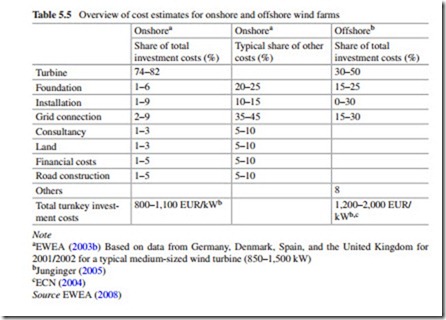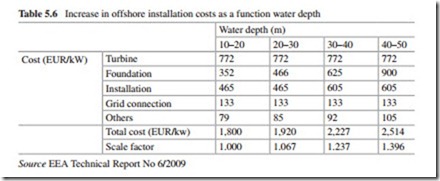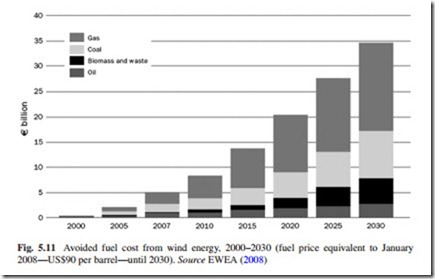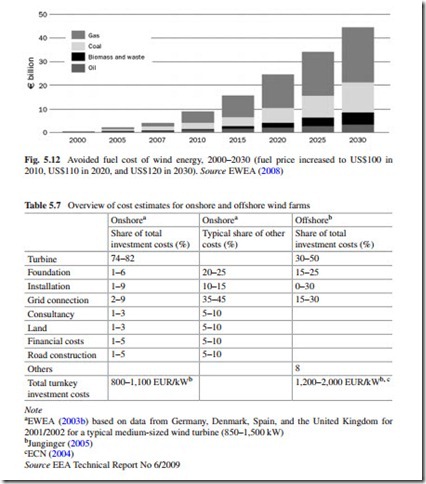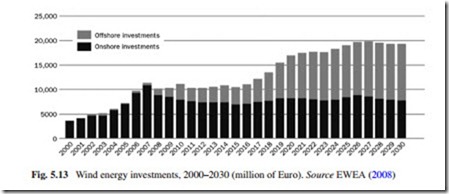Wind Power Costs
Wind energy involves no fuel price risk, as there is no fuel. On the other hand, the main parameters determining the cost of wind energy are investment costs (i.e., turbine costs, foundations, electrical installations, connections to the electrical grid, consultancy fees, land costs, financing, security, and road construction) and operation and maintenance costs. As costs depend on various factors, they also vary significantly between different countries. The capital costs of wind energy projects are dominated by the cost of the wind turbine itself (ex-works). An aver- age turbine installed in Europe has a total investment cost of around €1.23 million per MW. The turbine’s share of the total cost is, on average, around 76 %, while
grid connection accounts for around 9 % and foundations for around 7 %. The cost of acquiring a turbine site (on land) varies significantly between projects, so the figures in Table 5.5 are only to be taken as examples. Other cost components, such as control systems and land, account for only a minor share of total costs. Also, for other costs, such as foundations and grid connection, there is consider- able variation between countries, ranging from around 32 % of total turbine costs in Portugal to 24 % in Germany, 21 % in Italy, and only 16 % in Denmark.
However, costs vary depending on turbine size as well as the country of installation. In terms of variation, the single most important additional component is the cost of grid connection, which, in some cases, can account for almost half of the auxiliary costs, followed by typically lower shares for foundation cost and the cost of the electrical installation. Thus, these auxiliary costs may add significant amounts to the total cost of the turbine. Cost components such as consultancy and land usually only account for a minor share of the additional costs.
The cost of producing electricity from the wind is heavily dependent on the local wind regime. The power output from the wind machine is proportional to cube of the wind speed and so a slight increase in wind speed will mean a sig- nificant increase in power and a subsequent reduction in unit costs. Capital costs of wind power are high, but running costs are low and so access to initial funds, subsidies, or low-interest loans is an obvious advantage when considering a wind– electric system. If a hybrid system is used, a careful cost–benefit analysis needs to be carried out. A careful matching of the load and energy supply options should be made to maximize the use of the power from the wind—a load which accepts a variable input is ideally matched to the intermittent nature of wind power.
When assessing wind energy potential for the coming decades, it is necessary to take into consideration one of the main elements that affect the cost of the use of wind energy for the generation of electricity: the technological and economic developments of wind turbines. These include factors such as rated power, hub height, and turnkey investment costs. According to EWEA information, wind turbine size has increased significantly, from an average rated power of less than 50 kW at the beginning of the 1980s to over 1 MW in 2000s. The commercial size sold today is typically 750–2,500 kW It is important to note that current turnkey wind energy costs are estimated to be around €1,000 per kW for onshore and between €1,200 and 2,000 per kW for offshore wind farms (Junginger 2005; ECN 2004). Table 5.5 presents an over- view of cost estimates for onshore and offshore derived from various studies. It is evident that onshore wind energy costs are dominated by turbine costs, which is influenced by the turbine size. Because of economies of scale, turbine sizes may increase in the coming years. For instance, EWEA assumes an average wind turbine size of 10 MW in its briefing paper “No Fuel” (EWEA 2006). The rotor diameter of such large turbines would be around 150 m.
For offshore wind, the costs of foundation and grid connection can make up a significant share of investment costs. Investment costs for offshore wind are currently significantly higher and have increased considerably over recent years due to high steel prices and the shortage of offshore wind turbines. It is assumed that current high prices for wind turbines are short-term increases and that the mar- ket will adjust to price levels that better represent real costs. The situation may improve already when new manufacturers enter the market.
Wind turbine costs are the major part of onshore wind energy investment costs; thus, the main focus is given to those costs.5 At the turn of the century, wind turbine costs were reported to be between €750 and €1,000 per kW (Junginger 2005; Neij et al. 2005). However, wind turbine investment costs are expected to decrease further over time. As a rule of thumb, turbine manufacturers expect the production costs of wind power to decline between 3 and 5 % for each new generation of wind turbines (EWEA 2003b).
Based on experiences from Denmark, Germany, Spain, and the UK, EWEA (2003a) report that operational and maintenance costs are, in general, estimated to be approximately between €0.012 and €0.015 per kWh of produced wind power over the total lifetime of a wind farm. Operational and maintenance costs, thus, correspond between 2 and 3 % of total turnkey investment costs in the early years of the farm and around 5 % at the end of the lifetime (EWEA 2003a). Operational and maintenance costs for offshore wind farms are estimated to be between 2 and 4.4 % of turnkey investment costs (Junginger 2005).
According to the EEA Technical Report No 6/2009, offshore investment costs are dominated by turbine (30–50 %),6 grid connection (15–30 %), and foundation cost (15–25 %). Current high price levels of wind turbines create a different pic- ture on the split between the different cost elements. The construction of offshore wind parks at locations further from the shore often implies placement in deeper waters and changed weather conditions. Of the cost items listed, installation and grid connection costs are those most affected when offshore wind parks are located further from the shore (Table 5.6).
At larger distances, installation costs increase because of the greater traveling time needed for the holding port to the site. In addition, weather conditions usually worsen further offshore making installation more difficult. Investment cost of off- shore wind farms is also influenced by the onshore distance to the grid. According to Papalexandrou 2008, onshore cable cost is equal to €0.65 million per offshore cable used (export cable) per km of onshore cable. The effect on installation costs is minimal for wind turbines and foundations because the cost share of the traveling to the site is low compared to total installation costs. The costs most affected by the distance to shore are the cable installation costs within the total electrical installation costs. The factors influencing cable costs are cable size, sea bed
conditions, and the possible need for transformer stations. Experts estimate costs of offshore cables (excluding transformation stations) at between €500,000 and €1 million per kilometer (International Association of Engineering Insurers 2006). Another study estimates costs of supply and installation of export cable at €1 mil- lion per kilometer of offshore cable (Papalexandrou 2008). The share of grid connection cost in total investment cost decreases as wind farm size increases.
Assuming fuel prices equivalent to US$90 per barrel of oil, according to Zervos and Kjaer (2008), fuel costs avoided due to wind would be €5 billion in 2007, €8.3 billion in 2010, €20.5 billion in 2020, and €34.6 billion in 2030 (see Fig. 5.11).7 For other fuel prices, then the avoided fuel cost of wind energy during the period 2000–2030 is shown in Fig. 5.12.
Summing up the following can be stated:
• Weather downtime—a concept used to represent the additional time needed to install offshore—is usually between 20 and 30 % of the total investment;
• Export cable costs €1 million per km including installation and that the relation-
ship between distance from shore and grid connection cost;
• Offshore investment cost might increase from €1,800 to €2,878 per kW as the distance to the coast (Table 5.7).
According to expert calculations, foundations may account for up to 30 % of the total cost in deeper waters. In a report published by Greenpeace (2000), the
relationship between water depth and foundation cost is derived. For offshore wind turbines with capacities between 1 and 1.5 MW, the foundation costs are estimated to increase from €317,000 at eight meters depth to €352,000 at 16 m depth, a cost increase of 11 %. Finally, according to Papalexandrou (2008), foun- dation supply costs can differ from €300,000 per MW at 15 m to €1,000,000 per MW at 40 m, using monopiles.
The EC, in its Renewable Energy Roadmap, assumes that onshore wind energy cost is €948 per kWh in 2007. It also assumes that costs will drop to €826 per kWh in 2020 and €788 per kWh in 2030.
The market is expected to stabilize at around €10 billion per year up to 2015, with a gradually increasing share of investments going to offshore. By 2020, the annual market for wind power capacity is expected to have grown to €17 billion annually, with approximately half of investments going to offshore. By 2030, annual wind energy investments in the EU-27 are expected to reach almost €20 billion, with 60 % of investments offshore.
Cumulative investments in wind energy over the three decades from 2000 to 2030 are expected to be €390 billion. According to EWEA’s reference scenario (see Fig. 5.13), approximately €340 billion is expected to be invested in wind energy in the EU-27 between 2008 and 2030. This can be broken down into €31 billion in 2008–2010, €120 billion in 2011–2020, and €188 billion in 2021–2030 (Zervos and Kjaer 2008).
For onshore wind power plants, the specific overnight construction costs are in the range of US$1,900–US$3,700 per kWe. The construction period for onshore wind power plants ranges between one and two years in the majority of cases. It is important to highlight that the liveliest costs of electricity produced by onshore wind and solar PV technologies exhibit a very high sensitivity to the load factor variation, and to a lesser extent to the construction cost. In contrast with nuclear and thermal power plants with a generic load factor of 85 %, plant-specific load factors were used for renewable energy sources. For variable renewable sources, such as wind, the avail- ability of the plant is in fact an important driving factor for the levelized cost of gen- erating electricity. The load factors of wind power plants range between 21 and 41 % for onshore plants, and between 34 and 43 % for offshore plants.
